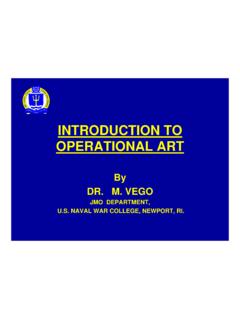Transcription of China’s Near Seas Combat Capabilities - Andrew S. Erickson
1 CHINA MARITIME STUDIES INSTITUTE naval WAR college newport , Rhode IslandChina s Near seas Combat Dutton, Andrew S. Erickson , and Ryan Martinson, EditorsNaval War CollegeNewport, Rhode Island Center for naval Warfare Studies China Maritime Study No. 11 February 2014 President, naval War college Rear Admiral Walter E. Carter, Jr., NavyProvost Amb. Mary Ann PetersDean of naval Warfare Studies Robert C. RubelDirector of China Maritime Studies Institute and editor-in-chief of the China Maritime Studies series Peter DuttonNaval War college PressDirector: Dr. Carnes Lord Managing Editor: Pelham G. BoyerTelephone: Fax: DSN exchange: 841 E-mail: Web: in the United States of AmericaThe China Maritime Studies are extended research projects that the editor, the Dean of naval Warfare Studies, and the President of the naval War college consider of particular interest to policy makers, scholars, and analysts.
2 Correspondence concerning the China Maritime Studies may be addressed to the director of the China Maritime Studies Institute, To request ad-ditional copies or subscription consideration, please direct inquiries to the President, Code 32A, naval War college , 686 Cushing Road, newport , Rhode Island 02841-1207, or contact the Press staff at the telephone, fax, or e-mail addresses and printing is subject to the Copyright Act of 1976 and applicable treaties of the United States. This document may be freely reproduced for academic or other noncommercial use; however, it is requested that reproduc-tions credit the author and China Maritime Studies series and that the Press editorial office be informed. To obtain permission to reproduce this publication for commercial purposes, contact the Press editorial 1943-0817 ISBN 978-1-935352-16-7 ContentsCHAPTER ONE Chinese Houbei Fast Attack Craft: Beyond Sea Denial.
3 1 by John PatchCHAPTER TWO Underwater TELs and China s Antisubmarine Warfare: Evolving Strength and a Calculated Weakness ..17 by William S. MurrayCHAPTER THREE China s Second Artillery Force: Capabilities and Missions for the Near seas ..31 by Ron ChristmanCHAPTER FOUR Aerospace Power and China s Counterstrike Doctrine in the Near seas ..49 by Daniel J. KosteckaCHAPTER FIVE Chinese Air Superiority in the Near seas ..61 by David ShlapakCHAPTER SIX Land- and Sea-Based C4 ISR Infrastructure in China s Near seas ..75 by Eric D. PedersenCHAPTER SEVEN Chinese Air- and Space-Based ISR: Integrating Aerospace Combat Capabilities over the Near by Andrew S. EricksonCHAPTER EIGHT China s Surface Fleet Trajectory: Implications for the Navy ..119 by Timothy A. Walton and Bryan McGrathAbbreviations and Definitions ..132 About the Contributors.
4 136 The capstone Defense Department study on the future operational environ-ment declares, China s rise represents the most significant single event on the international horizon since the collapse of the Cold War. 1 Understanding and assessing changes in China s traditionally defensive naval strategy, doctrine, and force structure are of obvious importance to the Navy (USN) and other Pacific navies concerned with the possible security implications of that rise. This chapter examines the development of the Chinese navy s Houbei (Type 022) fast-attack-craft force and its roles and missions in China s near seas and discusses implications for the Navy and other navies in the region. The author argues that this force, when integrated with People s Liberation Army Navy (PLAN) units and task groups in joint operations, provides an offensive sea-control capability beyond simple coastal defense (coastal defense here being a limited form of sea denial).
5 Indeed, linked fast attack craft operating collectively may present a significant potential offensive threat to American capital ships and strike groups well beyond the Origins of the Houbei Fast Attack CraftPLAN doctrine outlined the purpose of the fast-attack-craft force as early as 1950. Bei-jing sought a modern, lightly armed offshore coastal-defense element to place alongside the key PLAN forces, naval aviation and These fast-attack-craft units con-sisted of relatively fast (thirty-plus knots), single-mission hulls, including subchasers and torpedo boats (later, guided-missile boats) that operated in speedboat zhidui ( flotil-las ).4 Early fast attack craft were adequate to the coastal-defense missions of countering Nationalist Chinese invasions and later, Soviet and American amphibious threats over home waters;5 they were available in large numbers and could be rapidly deployed along interior lines.
6 They were, however, very limited in endurance and Nonetheless, because PLAN resource limitations precluded the development of large combatants be-fore the 1980s, the occasional maritime clashes that did occur involved fast attack craft including the sinking of several adversary fast attack craft and small combatants. John PatchBeyond Sea DenialChinese Houbei Fast Attack Craft CHAPTER ONE2 c h i na m a r i t i m e s t u d i e sIn the 1980s the PLAN commander, Adm. Liu Huaqing, played an important role in changing the service s mission (and mind-set) from coastal defense to offshore de-fense or near- seas active defense with a commensurate change in fast-attack-craft roles and missions. Naturally, this doctrinal shift called for a different force to cover a much larger area, a force relying less on fast attack craft for coastal defense and requir-ing more offshore-patrol vessels for longer-duration patrols in the three near seas .
7 Fast attack craft still had a significant support role for amphibious operations against Taiwan, but other near- seas missions, like protection of sea lines of communication and patrol of the exclusive economic zone (EEZ), demanded a new force of multimission vessels with improved blue-water seakeeping and endurance. During this period, accordingly, PLAN fast attack craft, numbering some two hundred by 1990, obsolesced as demand As the PLAN cast its gaze beyond the EEZ, however, the need for a modern, offensive fast attack craft became apparent. Offshore-patrol vessels persisted, and in greater numbers than fast attack craft (they continue their missions to the present), but they could not serve as fast attack craft in the modern sense. The Houbei class answered that requirement. Sources on PLAN requirements for a new fast attack craft are either unavailable or pro-tected, but it seems clear from early acquisition activity that the need for a modern fast attack craft had become pressing by around 1998.
8 For example, China sought to acquire Molniya-class fast attack craft from Russia in the early 2000s, though the sale never reached Houbei hulls began appearing in 2004. The Houbei represented a marked change from previous-generation fast attack craft and offshore-patrol vessels. It is not just a replacement for the Chinese versions of the Osa and Komar coastal-defense fast attack craft; it represents a capability shift decidedly in the offensive direction, a shift relevant to the active defense aspect of near- seas opera-tions. ONI analysts emphasize Houbei s better sea keeping, speed, and mission flex-ibility in comparison to the older missile It is certainly not simply an offshore-patrol vessel replacement, as the Type 037 variants are still relatively capable and thus not in dire need of replacement; in any case, the Houbeis do not have the offshore-patrol vessels long range or endurance.
9 While still viable for other missions, the older Houjian, Houxin, Haiqing, and Haijiu classes cannot serve as modern fast attack craft: they are too slow, most are not data-link capable, and none have long-range antiship missiles. The PLAN designed the recently re-vealed Type 056 corvette to replace the Houjian with an escort and air-defense mission for the farther reaches of the near seas a development supporting the assertion that the Houbei is not a follow-on offshore-patrol For now, the more than sixty Combat operational Houbeis constitute the sole modern PLAN fast-attack-craft c h i na s n e a r s e a s c o m bat c a pa b i l i t i e s 3 Houbei within a Changing naval StrategyThere is no question that the PLAN is evolving to meet expanding regional missions and that the Houbei class will play an important role. What is less clear is how China is evolving its strategy, doctrine, and operational concepts to meet new near- and far- seas The PLAN is transforming its force structure to make it more appropri-ate for offensive operations beyond the traditional littoral tether.
10 Gaps persist in the body of literature with respect to this transformation, but it is possible to assess the part that fast attack craft play. Similarly, since the recurring Chinese white papers do not move much beyond generalities, open-source material and PLAN operations and exer-cises provide important evidence on key developments. Finally, the near- and far- seas concepts are not really formal strategies in the Western sense indeed, there does not appear to be any Chinese naval or maritime strategy comparable to Still, it is instructive to use near/far- seas concepts in a strategic sense. It is important to note that with an expectation of increasing far- seas missions for larger PLAN combatants, fast attack craft will, logically, need to be relevant well outside coastal waters. The far- seas concept endorsed since the mid-2000s, for instance, clearly requires a PLAN that will operate with increasing reach and with offensive The Center for naval Analyses assesses that Beijing s intent to extend its strategic depth for active defense is an expansion of the armed forces geographic and functional security interests.









